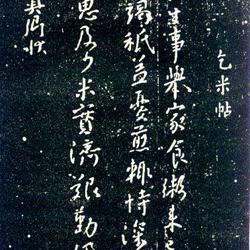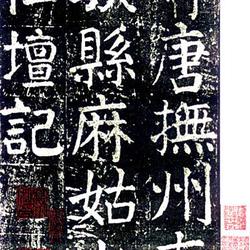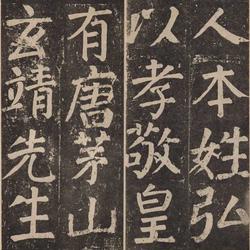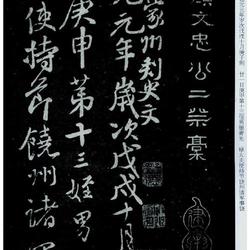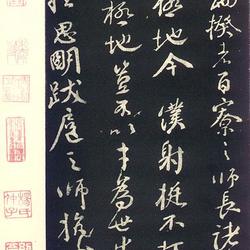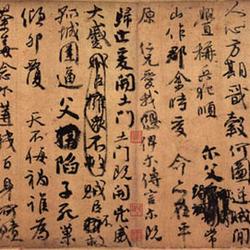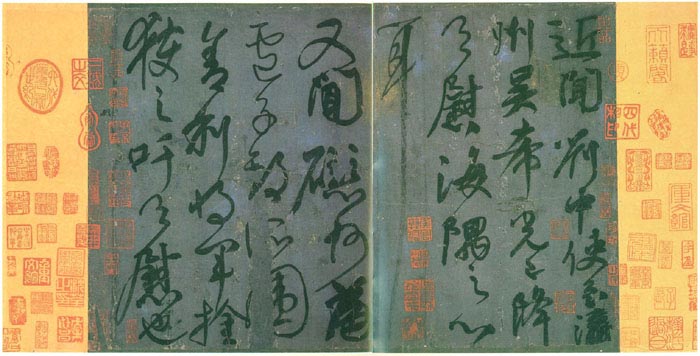
Yan Zhenqing's "Liu Zhong Envoy's Note" was written in the tenth year of the Dali calendar (775). Ink marks. Running script, letters. 28.5×43.1 cm. Every 8 lines contains 41 words. Collection of the National Palace Museum, Taipei
This post is also called "Yingzhou Post". It was first recorded in "Xuanhe Shupu" of the Song Dynasty. There is no writing date. "Liu Zhongshi Tie" is the largest font in Yan Xing's cursive script. The article said: "I recently heard that Liu Zhong's envoy arrived in Yingzhou and Wu Xiguang has descended. This comforts Haiyu's heart and ears. I also heard that Cizhou was besieged by Lu Ziqi and General Relic captured him. This comforts me."
This is a post that has been circulated for a long time. According to "Qinghe Painting and Calligraphy Boat": "Yingzhou Tie" written in large characters by Yan Zhenqing is a relic of the imperial palace of Xuanhe in the Song Dynasty. It was collected by Zhang Ke and his family in the early Yuan Dynasty." According to the postscript written by Wang Zhi after the Tie: Zhizheng 23rd year (1363) Years), Wang Zhi once obtained Lu Jian's "Lanting Poems" and Ouyang Xun's "Bu Shang Tie" from Zhang Xiaojiang. During the Jiajing period of the Ming Dynasty, he returned to Xiang Yuanbian's "Tian Lai Pavilion" and later moved to a factory. In the early Republic of China, he returned to Li Shizeng. There are two and a half seals of "Sanhuai" and "Yuesheng" in the seal, as well as identification seals of "Shaoxing", "Zhang Yan's private seal", "Wang Zhi", "Xiang Yuan Bian seal" and so on. Later, there were inscriptions by Yuan Wang Yingsun, Xian Yushu, Zhang Yanqing, Bai Zhanyuan, Tian Shimeng, Mingwen Hengshan, Dong Sibai and others. The Ming Dynasty "Xihongtang" post is also engraved.
Liu Zhongshi, named Liu Qingtan. In the 10th year of Dali (AD 794), Tian Chengsi, the former An Lushan and Shi Siming general who surrendered to the imperial court, launched a rebellion and occupied Yingzhou and other places. He also sent Lu Ziqi to besiege Yingzhou. The imperial court sent troops to attack, and Wu Xiguang surrendered. Lu Ziqi was captured and taken to the capital, where he was executed in November. At that time, Yan Zhenqing was sixty-seven years old and was serving in Huzhou. When he heard the news of the two military victories of the Tang Army, he became emotional and wrote this note. There is no mention of Lu Ziqi's execution in the manuscript, so it should have been written before November of that year.
This work has always been valued by calligraphers. Xian Yushu of the Yuan Dynasty commented: "The heroic spirit can be seen in the brush strokes." Zhang Yan also praised: "Looking at his brush strokes, there is a generous and loyal attitude to Wen Jie." Wen Zhengming of the Ming Dynasty believed that "this calligraphy is the best" among the extant Yan calligraphy. The whole post is majestic, the writing force is vertical and horizontal, showing a heroic and bold demeanor. The writing is strong and graceful. The turning points between words are sometimes connected, sometimes broken, and the writing is smooth. , done in one go. The last stroke of the word "ear" is so long that it occupies a whole line. The feeling of joy can be expressed in one line. The love is endless and the meaning is not finished, so the characters in the second half are larger than those in the first half, which feels soothing to the heart, and the lines are more elegant and continuous. Two characters in the fifth line are connected, three characters in the sixth line are connected, and four characters in the seventh line are connected, and they seem to be full of emotion. Dong Qichang called it "delicate and unique, and has a unique interest beyond the laws of the two kings".
Explanation:
I recently heard that Liu Zhong's envoy has arrived in Yingzhou and Wu Xiguang has surrendered. It comforts Haiyu's heart and ears. I also heard that Cizhou was besieged by Lu Ziqi and General Relic captured him. Calling for comfort.
Appendix: "Liu Zhong's Envoy's Notes" written by a piece of paper
(Source: "Appreciation of Calligraphy of the Past Dynasties" by Chen Zhenlian)
According to the Song Dynasty's "Huanhe Shupu", there are twenty-eight kinds of Yan Zhenqing's ink in Xuanhe's inner palace. This is of course a very rare number. Several famous dharma calligraphy handed down from generation to generation, such as "Struggle for Seats", "Cai Mingyuan", "Zhushan Hall Poetry", "Liu Taichong", "Nephew Memorial Calligraphy", "Liu Zhongshi", "Huzhou Calligraphy", etc. are all included. After sorting through these works, I have a deeper understanding of the prominent position of "Liu Zhongshijie" in Yan Zhenqing's short slips. I think: apart from long and giant works like "Sacrifice to Nephew", apart from In addition to Yan Zhenqing's inscriptions, "Liu Zhong Envoy's Letter" stands out among others. It is not only second to none among Yan's books, but also a rare masterpiece even among the ancient and modern Dharma books of famous masters.
To say that it is a divine product is to first of all feel that it perfectly embodies the strong character of Yan Shu. In fact, Yan Jin Liu Gu respectively refers to their regular script and words, and cursive script may not be included. However, due to the coordination characteristic of one person's calligraphy style, there should be some similarities between regular script and running cursive script. Liu Gongquan's understanding of "bones" is reflected in both the regular script "Shence Army Stele" and the cursive "Mengzhao Tie", and he is a coordinator; Yan Zhenqing's regular script such as "Yan Qinli", "Yanjia Temple" and other stele and cursive scripts Compared with "Tie for Seat" and "Tie for Nephew", the regular script has a strong "string" feeling, while the cursive script has sharp stipples and great impact, but they are two different tones. Among the princes of the Tang Dynasty, Ouyang Xun was close to Liu and Yu Shinan was close to Yan. Ou was harmonious while Yu was not. This can be understood by comparing "Meng Dian Tie" and "Epitaph of Princess Runan" with Ou Yu's regular script writing respectively. .
"Liu Zhongshi Tie" allows us to review the characteristics of Yan Shu's strong muscles. The so-called "point is like a falling stone, painting is like a cloud, the hook is like bending gold, and the strike is like a crossbow" are enough. Especially the ratio of Qu Jin's crossbow is used to reveal the beauty of the elasticity of the lines in this post. Under the constraints of Yan Shu's broad structure, we can see more of the beauty of richness and elasticity in the movement of lines from this post. I think this is the strongest aesthetic message conveyed in "Liu Zhongshi Post". In addition, the clear and decisive strokes of the lines when they are connected and connected also force us to take into account the strong side of this post in addition to appreciating its richness. For example, the long straight line of the word "ear" is straight down, its momentum is fast, its meaning is powerful, and the lines are quite like Yan Zhenqing's writing experience described by Zhang Xu: "A cone scratches the sand."
"I recently heard that Liu Zhong's envoy arrived in Yingzhou, and Wu Xiguang has surrendered. It comforts the hearts and ears of Haiyu. I also heard that Cizhou was surrounded by Lu Ziqi, and General Sheli captured him. Calling! It comforts me." In the eventful autumn when rebellions broke out in the Tang Dynasty, , Yan Zhenqing’s loyalty to state affairs, doesn’t it have to be found only in “Nephew Memorial Notes”? Don't the words of "Liu Zhong's Letter", coupled with its powerful lines and images, also give us a glimpse of the heart of loyalty to the sun and the moon?

